|
This year, 2005, marks the 30th anniversary of the launch of the Triumph
TR7. Designed as the corporate sports car by British Leyland,
the TR7 was intended to replace the venerable Triumph TR6 as well
as the Triumph GT6, and MG's ageing MGB Roadster and MGB GT coupe.
Indeed plans were afoot for the TR7 platform to spawn a new generation
of Triumph and BL Group vehicles, a point made in May 1975 by
Road & Track "Finally something has emerged from BL's
engineering departments, and it's only the first of several new
sports cars we'll see over the next three years". Instead
a work-shy, malcontent workforce saw that the early TR7's were
beset with quality problems, coupled with dithering management
and poor judgement on automotive legislation the TR7 ultimately
befell a premature demise and the derivatives never saw the light
of day.
The production run of the TR7 began in earnest in late
1974, dropping from the womb of Speke in FHC form for the North American
market and finished seven years later - on Monday 5 October 1981 popping
from the loins of Solihull, the vehicle's third mother in its torrid
production life. In all we can say that with the industrial action,
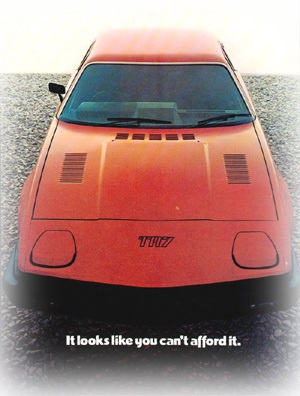 moving
of the tooling and equipment from Speke to Canley to Solihull the car
was really built for a little over 6 years. moving
of the tooling and equipment from Speke to Canley to Solihull the car
was really built for a little over 6 years.
But let us not dwell on the death of the wedge as this is a celebration
of its launch. With production beginning in late 1974 the car
was first unveiled at Boca Raton - about 16miles (as the crow
flies) north of Fort Lauderdale - on January 15th 1975 with showroom
sales commencing on 2nd April. Such was the demand from the North
American market that the intended Autumn launch for the European
model was delayed until May of 1976.
So what did people think of the Triumph TR7 back in 1975 when the "Shape
of Things to Come" was pushed out to the World (well America)?
The first comment that struck me (from Road and Track, April 1975) was
"we had hoped to have a full road test of the TR-7… but
unfortunately a strike in England (what else is new?) prevented British
Leyland starting production on time and the cars shown to the press
at Boca Raton, Florida, were pilot models" Did those responsible
for the industrial action realise that they really were drawing up their
own redundancy papers? Despite the cars being 'pilots' and therfore
subject to a more studied assembly the components were not of the highest
quality. Which meant that even at the official launch Triumph were displaying
- and offering the press test drives in - vehicles which were not of
acceptable quality. Despite this Road & Track were rather benevolent
and highlighted that a true review of the vehicle's drive and handling
would be of little value - due to the differences between the pilots
and the full-production vehicle.
Reading the early reviews - and I refer only to those of 1975 that
focus on the Speke vehicles - one common theme which is clearly evident
is that variants of the TR7 were expected. In the Road and Track Technical
Analysis article from their April edition (carrying the sub-heading
of "…the most important new British sports car in 14 years")
they say "…it also seems fairly obvious that the Sprint
16-valve engine will eventually find its way into some version of the
TR-7." The Sprint reference also appeared in Autocar for the
week ending 25th January 1975, claiming that "The Dolomite Sprint
Engine is an obvious card Triumph are keeping up their sleeve."
Little did they suspect that with the impending Romany lifestyle of
TR7 production that British Leyland would cancel the Sprint and Lynx
prototypes - despite development being at an advanced stage. Sports
Car World (Sept 1975) stated in their leading sentence "Triumph's
new sporty looks like a mid-engined car but in reality it's utterly
conventional. Never mind, there's a V8 version just around the corner."
Rather than 'just around the corner' the V8 was actually around a long,
gentle bend, through the next town and over the brow of that hill in
the distance. In the same "The Great Pretender" article they
wrote "Later will come a potent fuel-injected version of the
16-valve engine, and probably the Rover 3.5-litre V8." Oh how
the people were deceived. It's interesting looking back that it was
the Sprint engined variant that seemed to be the model that was most
desired.
Styling
Virtually everyone has an opinion on the styling of the TR7. Whether
it's a GT6 owner (who longs to go for a drive without baking himself),
or the Queen who whinged about the lack of space for her Corgi's and
the problems encountered when trying to get in the car "without
dislodging One's crown". You then get the well known comment, made
at the Geneva Motor Show of 1975, by Giorgetto Giugiaro when, after
looking at one side of the TR7, he viewed the other and exclaimed "My
God! They've done it to the other side as well!". Now many
interpret this as a shocked, statement of disapproval. Personally I
think he was in awe of the styling and he has been misrepresented over
the years… after all he worked (when with Ital) with the BLMC on
the Austin Marina and Princess (or as they became the Morris Ital and
Ambassador), and surely BLMC wouldn't associate themselves with someone
who took the mickey out of the TR7.
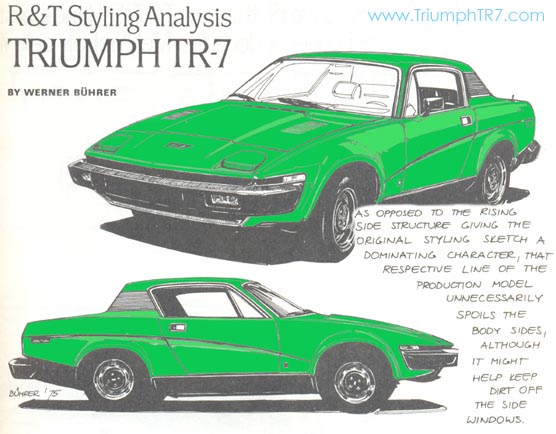
Oh and I'm a little hazy on the source of the
comments regarding the Queen. So if you bump into her you may
be best not to quiz her to thoroughly about the TR7 okay? If you
must ask any royalty at all you may be better off speaking to
Prince Philip - he's (allegedly) a cylinder short of a v8 these
days and may tell you about the time he helped Malaysian goat
herders get their flocks down a mountain by loaning them his DHC.
The press tended to sit on the fence a little bit "The
shape is marginally better than the brick-like TR6…"
Hmmm. Maybe I should say that Auto-Car (w/e 25 Jan 1975) were
referring to the aero-dynamic qualities and the reduced drag co-efficient,
and not the actual styling. Later in the year when finally receiving
a test car Road and Track (May 1975) didn't comment on the looks
other than to say "… a strange stubby shape"
though in summation saying "Aesthetics [sic] aside:"
would suggest that the author of the piece wasn't too enamoured
by the TR7's looks. In the same issue Werner BÜhrer has a
short 'Styling Analysis' stating that the swage line "spoils
the body sides" however he has an interesting (or maybe
not!) theory about the swage lines in saying that they "might
help keep dirt off the side windows". Overall Werner
believes an opportunity of "creating an advanced sports
car" was lost. Though Harris Mann's design was more original
than that of Fiat's X1/9 Werner goes on to say that the TR7 "lacks
the charm [and] originality" of some of its older contemporaries
such as the Healey Sprite, MG TC or that of the TR4. The confusion
on the styling and the differing opinions it provoked - and still
provokes - was highlighted in the Sept 1975 edition of Sports
Car World when they wrote "From the front it's handsome…
from the rear and rear three quarters the high tail and strange,
curving crease rising along the flanks make the car look awkward.
Overall it's attractive in a crudely rakish sort of way."
Is that at thumbs up? Would the following line upset the TR 'purists'
(as some enthusiasts saw themselves) "Although it has
a fixed roof let it be said from the outset that it is an immeasurably
better car than the old TR6".
The Drive
The TR7 was often mistaken for a mid-engined car - an approach that
BL had dropped on safety fears despite Jaguar, MG and Rover all producing
prototypes. British Leyland believed that in a frontal impact the driver
should not be positioned between the engine and the impact. As Sports Car World (Sept 1975) put it "BLMC considers
that a front engined car makes a better battering ram". The
mid-engine idea is a theme which dominates Sports Car World's article
though they praise the handling of TR7 - stating that it is as good
as the more upmarket European sedan/saloons and lauds the comfort in
comparison to other sports cars that have come before it… "especially
sports cars from BL". Though the author credits the TR7 with
being "controllable and fun to drive" he still doesn't
rate the road holding alongside that of the mid-engined rivals.
impact. As Sports Car World (Sept 1975) put it "BLMC considers
that a front engined car makes a better battering ram". The
mid-engine idea is a theme which dominates Sports Car World's article
though they praise the handling of TR7 - stating that it is as good
as the more upmarket European sedan/saloons and lauds the comfort in
comparison to other sports cars that have come before it… "especially
sports cars from BL". Though the author credits the TR7 with
being "controllable and fun to drive" he still doesn't
rate the road holding alongside that of the mid-engined rivals.
The ride and handling seems to satisfy the reviewers of these early
cars - most of us know that the UK press (in particular) disliked the
ride given by the TR7 as it lacked the true sporty character that they
wanted… but the car was built for the American market and therefore
it was this sector that needed to be appeased! The live rear-axle is
often compared to the IRS (Independent Rear Suspension) of the TR6 and
though all articles agree that an IRS system can be better it is universally
acknowledged that a good live set-up is better (and cheaper) than a
poor IRS. All of the earlier reviewers praise the characteristics of
the handling and mention mild understeer. Road & Track seem to think
the cornering ability (generating 0.743 of g-force) is something to
shout about "You corner briskly and find the TR-7 has cornering
power to spare" they go on "at least the U.S. government
hasn't yet regulated handling. Here is where the TR-7 is miles ahead
of any Triumph sports car ever built" and on "…gives
the driver confidence and this is backed up by a lot of cornering power
and good response characteristics" though I am not convinced
by "the TR-7 is a distinctly pleasant car to drive fast"
which is a bit like saying "it's nice"… sort of wishy
washy and "oh it's okay" you could almost say "the car
is a bit beige, a bit slipper like, yeah it's alright I suppose".
Others are more enthusiastic, and even the R&T reviewer gets a little
more worked up later in saying "In general the TR-7s ride is
outstanding for a small sports car.", elsewhere "But
if the TR7 rides so softly, it's going to handle like a slush-bucket
right?" is asked by Sports Car World, who reply with the simple
answer "Wrong!".
What did the reviewers make of the braking system? Personally
I have always thought the standard brakes on a TR7 were shabby,
but 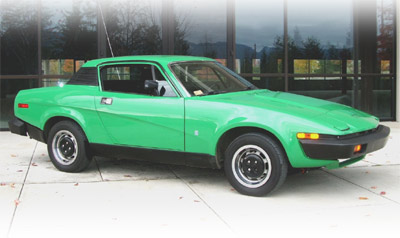 then
again I bought the car in 1990 having learnt to drive during the
late 80's in a 'new' Ford Fiesta and had since been driving parent's
vehicles which were somewhat newer than the 1976 TR7. The early
reviews were pretty unanimous in praising the braking set-up -
the 44% more effort required to bring the car to standstill, on
the 6th stop from 60mph (Road & Track), wasn't seen as an
issue. "The brakes work well… bringing the TR-7 to
a quick stop from high speeds with little work on the part of
the driver" Was R&T's comments on the pilot models
tested in January 1975 and they again praised the brakes in their
May issue: "…short stopping distances and excellent
directional control". Sports Car World was less enthusiastic
"Brakes are quite good" and were the only magazine
to raise the issue of the alarming dive that we experience under
hard braking "…certainly it would be better if the
nose didn't dip so hard." then
again I bought the car in 1990 having learnt to drive during the
late 80's in a 'new' Ford Fiesta and had since been driving parent's
vehicles which were somewhat newer than the 1976 TR7. The early
reviews were pretty unanimous in praising the braking set-up -
the 44% more effort required to bring the car to standstill, on
the 6th stop from 60mph (Road & Track), wasn't seen as an
issue. "The brakes work well… bringing the TR-7 to
a quick stop from high speeds with little work on the part of
the driver" Was R&T's comments on the pilot models
tested in January 1975 and they again praised the brakes in their
May issue: "…short stopping distances and excellent
directional control". Sports Car World was less enthusiastic
"Brakes are quite good" and were the only magazine
to raise the issue of the alarming dive that we experience under
hard braking "…certainly it would be better if the
nose didn't dip so hard."
As anyone who has driven the 4-speed TR7 and compared it to the
LT77 5-speed box (which came later) will know the 4-speeder can
be fussy and rather whiney over a prolonged distance at speed.
It seems that Road & Track noticed that a problem with the
pilot vehicles' gearbox had persisted into the production models
- "In general we liked the gearbox… but when driven
hard we found it too easy to beat the 2nd gear synchronizer, and
on the occasional down shift to 1st we got a slight crunch even
with careful double clutching. A problem we found in the prototype
TR-7 we drove earlier, which was supposed to be corrected in the
production car persists: a lot of noise from the differential,
especially when the driver eases off the throttle at medium or
high-speed."
When reading the early articles it must be remembered
that the vehicles being used were manual 4 speeders in '49 state'
tune… that being the 90bhp vehicle. I assume that Sports
Car World was comparing the TR7 2.0-litre 8-valve unit to the
Dolomite Sprint when they say "Not surprisingly, it has
no sparkle in US form and doesn't like to Rev….. But the
16-valve engine that's a different matter." However the
impression given by the early articles were that 90bhp, 11.3 seconds
to the 60 and a top speed of around 105mph were acceptable….
Though the common theme of the Sprint variants did, almost, subliminally
nod toward the consensus that the car didn't go "like a bullet"
as the adverts would have you believe. I did rather like the comment
"maximum torque occurs at 55mph so there's ample acceleration
for passing slowpokes" (Road & Track May 1975). And
it is still true today that the 2.0l 105bhp is sprightly enough
to get ahead of those who cruise around at just under the UK National
Speed Limit (60mph). Those cruising at that speed tend to have
just the one constant speed of about 48mph, it doesn't matter
whether that's through a village (30mph limit) or past a school
(20mph) or on a dual carriageway (70mph), but I digress.
Cabin
Cars built now help send you to sleep at the wheel, they are quiet.
Very quiet. Okay not all… I've heard the City Rover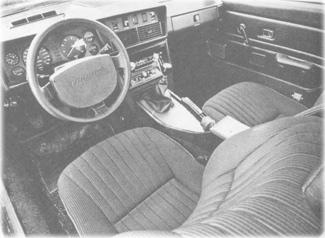 is bit of a dog and my own 1998 Ford Probe has more rattles than a baby
shop. But in general terms the cars are quiet, wind noise is minimal,
and road noise is well suppressed. In comparison my FHC is rather noisy…
however it has surprisingly few rattles - a fact that was picked up
by the testers 30 years ago. I wouldn't go quite as far as "You
drive off and find out very quickly that the TR-7's unit body is virtually
devoid of rattles, wind noise, or road rumble" and I don't
think the 175 tyres reduced the road rumble significantly from the 185's
that were fitted later.
is bit of a dog and my own 1998 Ford Probe has more rattles than a baby
shop. But in general terms the cars are quiet, wind noise is minimal,
and road noise is well suppressed. In comparison my FHC is rather noisy…
however it has surprisingly few rattles - a fact that was picked up
by the testers 30 years ago. I wouldn't go quite as far as "You
drive off and find out very quickly that the TR-7's unit body is virtually
devoid of rattles, wind noise, or road rumble" and I don't
think the 175 tyres reduced the road rumble significantly from the 185's
that were fitted later.
The monocoque shell - the very thing that apparently means the TR7
is not a 'real TR' (I love the blinkered attitude - the same people
probably throw a hissy fit if red ignition leads are fitted when that
model year had orange ones) - is highlighted as a factor in reducing
the shakes from the 7's forebears. "All Triumph TR's up to now,
however, have been characterized by a rather shaky body structure and
an unrefined chassis" say Road & Track, pointing out that
"Here the TR-7 couldn't be more different". And though
Sports Car World agrees that there's a "commendable suppression
of noise" they are less than impressed with the cabin space.
Likening the TR7, again, to that of a mid-engined vehicle they believed
that the cabin should have been more spacious "[the TR7] has
all of their [mid-engined vehicles] faults but none of their
advantages". Elsewhere the cabin space was a plus point, but
then again elsewhere they were not comparing the TR7 to the mid-engined
competition quite so routinely.
From a drivers perspective the expansive B-Pillars in particular came
in for heavy stick from all quarters, though Road & Track found
the forward visibility "a big disappointment" and believed
that the short coming in this area would mean "…that
[the] large wraparound front impact bumper will probably be put to
use in parking more frequently than the BL designers intended".
They also found (in May) that "the steering wheel leaves little
room for the legs to operate the pedals."
Continuing the viewpoint of the driver Autocar rather liked the cabin
"The cluster of dials and lamps is most pleasing to the eye….
reminiscent of the much praised big BMW arrangement". A theme
continued in Sports Car World who found the dials "easy to read"
and that they were "worked neatly into the overall layout".
Rather than complaining of the lack of clearance between the driver's
legs and the steering wheel Sports Car World went on to say that the
instrumentation and centre console "neatly encloses the driver's
thighs" and that the "driving position is first-class".
For some reason the headlamp switch falls foul of the Road & Track
reviewer… it apparently "bothered" him "because
you push it down to bring the headlights up". I've never been
bothered by it myself I have to say!!
Passenger comfort is rather glossed over, aside to mention the adjustable
head restraints and the "huge" glovebox which was uniformly
referred to as… well, as 'huge'. Though R&T believed this was
to leave "room for airbags, no doubt".
Impressions
Reading the reviews I got the underlying impression of 'cautious optimism'.
The reviews were generally favourable, though certainly there was not
any fawning and swooning going on. Maybe Road & Track came the closest
with "it's 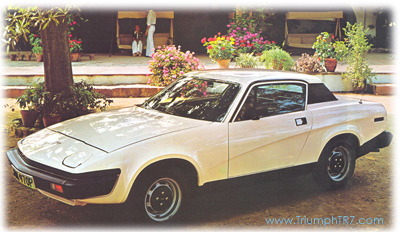 almost
as if Triumph had designed the car in response to our complaints about
the ancient TR-6"; though I should point out that this was
"aside from a strange and stubby shape" that I mentioned
earlier. They also believed that "British Leyland shouldn't
have much trouble selling a lot of TR-7''s at the $5100 asking prices". almost
as if Triumph had designed the car in response to our complaints about
the ancient TR-6"; though I should point out that this was
"aside from a strange and stubby shape" that I mentioned
earlier. They also believed that "British Leyland shouldn't
have much trouble selling a lot of TR-7''s at the $5100 asking prices".
Sports Car World found the TR7 to be "enjoyable and well sorted"
though they pleaded "Give it the 16-valve unit" as
it would then "be a flier" with the ability to "blow
the six-cylinder TR6 into the weeds".
In summation Road & Track captured the feelings of many at the
time "Esthetics aside; we think Triumph has done a generally
nice job with this new car… And finally, its prices seems reasonable
in today's context. You can't really ask much more than that, except
perhaps good looks".
So those of us with TR7's have a 'nice' car that was launched at a
'reasonable' price but lacked 'good looks'. Hmmm. Well who cares what
they think or thought!!!
I'll wrap up but saying that though the list price was $5100 you could
bump the cost up with the addition of a stereo radio (AM/FM) cassette
for an additional $200 or add air-con for $425.
|

